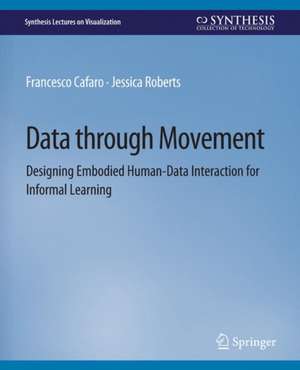Data through Movement: Designing Embodied Human-Data Interaction for Informal Learning: Synthesis Lectures on Visualization
Autor Francesco Cafaro, Jessica Robertsen Limba Engleză Paperback – 10 aug 2021
Preț: 356.35 lei
Preț vechi: 445.43 lei
-20% Nou
Puncte Express: 535
Preț estimativ în valută:
68.22€ • 71.18$ • 57.19£
68.22€ • 71.18$ • 57.19£
Carte tipărită la comandă
Livrare economică 13-27 martie
Preluare comenzi: 021 569.72.76
Specificații
ISBN-13: 9783031014826
ISBN-10: 3031014820
Pagini: 127
Ilustrații: XVIII, 127 p.
Dimensiuni: 191 x 235 mm
Greutate: 0.29 kg
Editura: Springer International Publishing
Colecția Springer
Seria Synthesis Lectures on Visualization
Locul publicării:Cham, Switzerland
ISBN-10: 3031014820
Pagini: 127
Ilustrații: XVIII, 127 p.
Dimensiuni: 191 x 235 mm
Greutate: 0.29 kg
Editura: Springer International Publishing
Colecția Springer
Seria Synthesis Lectures on Visualization
Locul publicării:Cham, Switzerland
Cuprins
Figure Credits List.- Foreword by Niklas Elmqvist.- Acknowledgments.- Introduction.- Understanding Human-Data Interaction.- Theoretical Foundations: Embodiment.- Background: Designing for Learning in Museums.- Background: Visualizations to Support Learning.- Designing Engaging Human-Data Interactions.- Designing Hand Gestures and Body Movements for HDI.- Embodiment and Sensemaking.- Conclusion.- Bibliography.- Authors’ Biographies.
Notă biografică
Francesco Cafaro is an Assistant Professor in the School of Informatics and Computing (SOIC) at Indiana University-Purdue University Indianapolis. Before joining SOIC as an assistant professor of human-computer interaction, Cafaro was a research assistant at the Learning Technology Group (Electronic Visualization Laboratory) of the University of Illinois at Chicago, where he served as a key collaborator on multi-disciplinary, federally-funded research projects. These efforts have produced prototype interactive exhibits for collaborative data exploration, first at the Jane Addams Hull House Museum in Chicago, and then at the New York Hall of Science in Queens. His research interests include embodied interaction, interaction design, and informal learning. His work is centered on the use of novel interaction techniques in support of STEM informal learning and cultural heritage. Specifically, he investigates how theories from learning, cognitive, and computer sciences can provide the scaffolding for the design of intuitive, embodied interactions. Dr. Cafaro's multi-disciplinary research has involved the design and evaluation of prototype exhibits at Discovery Place in Charlotte, North Carolina, and for the Historic New Harmony program in southern Indiana.
Jessica Roberts is an assistant professor in the School of Interactive Computing at Georgia Institute of Technology (Georgia Tech). Prior to joining Georgia Tech, Dr. Roberts conducted postdoctoral research at the Human-Computer Interaction Institute at Carnegie Mellon University and the Tidal Lab at Northwestern University. She holds a Ph.D. in Learning Sciences with a concentration in geospatial analysis and visualization from the University of Illinois-Chicago and a B.S. with a concentration in theatre design from Northwestern University. Her research examines how people learn through, with, and about data in out-of-school environments such as museums and citizen science activities and how interactive technologies mediate social, informal learning experiences. Her work on the design of interactive learning technologies has been exhibited at venues including the Field Museum of Natural History in Chicago and the New York Hall of Science.














